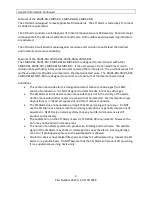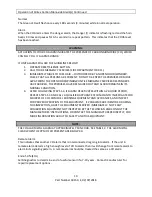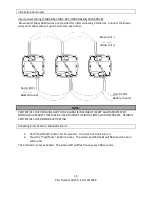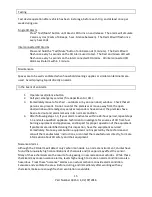
5
Part Number
18150, E, 02/07/2018
Table 1
200 PPM:
Slight headache within 2 to 3 hours.
400 PPM:
Frontal headache within 1 to 2 hours.
800 PPM:
Dizziness, nausea and convulsions within 45 minutes.
Insensible within 2 hours.
1600 PPM:
Headache, dizziness and nausea within 20 minutes.
Death within 30 minutes.
3200 PPM:
Headache, dizziness and nausea in 5 to 10 minutes.
Death within 30 minutes.
6400 PPM:
Headache and dizziness in 1 to 2 minutes.
Death in less than 15 minutes.
12800 PPM:
Death in less than 3 minutes.
Drug or alcohol use increases the effect of CO exposure. Individuals with cardiac or respiratory
conditions are very susceptible to the dangers of carbon monoxide. CO poisoning is especially
dangerous during sleep when victims are unaware of any side effects. The following are
symptoms that may signal exposure to CO:
• Headache
• Drowsiness
• Tightness of chest or hyperventilation
• Fatigue or Weakness
• Flushed face
• Inattention or Confusion
• Nausea
• Lack of normal coordination
Persons who have been exposed to carbon monoxide should be moved into fresh air immediately.
Persons who have been subjected to high concentrations of CO should be placed in the care of a
physician. To learn more about CO poisoning, contact your local health authorities.
Where Must We Guard Against Carbon Monoxide?
Carbon monoxide is a by-product of combustion. CO exists wherever fuels are burned to generate
power or heat. Recreational vehicles may utilize propane or compressed gas for cooking and/or
heating. Recreational vehicles have the added hazard of an auxiliary power generator where
exhaust fumes may drift into the vehicle. This hazard may also be created by a neighboring
vehicle’s exhaust fumes circulating into the cabin. The “station wagon effect”, is another hazard
that is caused by exhaust fumes that are captured via a rear opening while underway.
Recreational Vehicle Hazards
Recreational vehicles that are underway should close all rear windows and open a front window,
which may lend to pressurize the living spaces within the recreational vehicle. No sleeping,
particularly in rear compartments, should be permitted while underway. Occupants of the
“cockpit” should also maintain proper ventilation by opening a front window to drive “station
wagon” effect fumes away from the occupants. Extreme caution must be taken while parked with
an auxiliary power generator operating. Wind still nights can easily allow fumes to enter the
vehicle. Inspect the exhaust systems of propulsion and auxiliary generators frequently for
possible leaks. High concentrations of CO in your recreational vehicle may originate from an
adjacent vehicle. Exhaust fumes from nearby vehicles may enter your recreational vehicle
through open windows.



































